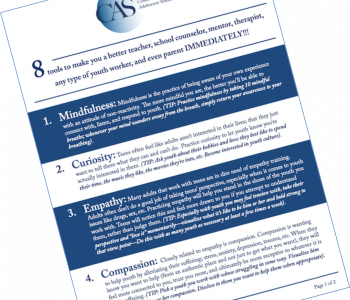

catharine hannay, ma
Catharine Hannay is the founder of MindfulTeachers.org and the author of Being You: A Girl’s Guide to Mindfulness, a workbook for teen girls on mindfulness, compassion, and self-acceptance.
Four Ways to Improve Difficult Relationships With Youth
In retrospect, it wasn’t such a great idea to tell my devout Christian mother I thought I was a pantheist.
I don’t blame her for freaking out. The poor woman must have imagined me performing Dionysian rituals in the backyard, assisted by our ever-accommodating golden retriever.
But I do fault her for this: after the initial freak-out, there was no follow-up discussion. She didn’t ask me what I meant or give me any chance to defend myself, just lectured me on what she herself believed and why I was wrong. It was yet more evidence of how ‘difficult’ I was, always saying or doing something to upset her.
When I look back at this incident from my own adolescence, and think about the many adult-teen confrontations I’ve witnessed or heard about in my years as a teacher, one thing is clear. There is quite often a way for the adult to improve the relationship. At minimum, there is almost always something the adult should not do in order to not make the situation any worse!
Here are four suggestions for parents, teachers, and other adults who may be caught in tense relationships with youth.
Tip #1: Practice Deep Listening
This is how I wish my mother responded.
“WHAT?! I’m not sure you really know what a pantheist is. Can you explain more about your beliefs?”
The truth is, neither of us had a clear understanding of pantheism. I wasn’t intending to be provocative or ‘difficult’ or rebellious. I was attempting to explain a spiritual connection to nature that was very hard for me to articulate as a fourteen-year-old.
This was the biggest problem I had throughout my adolescence; adults kept reacting to what I said without understanding what I meant.
In his course on Building Authentic Relationships with Youth, Dr. Sam Himelstein emphasizes the importance of Deep Listening. This means focusing calmly and compassionately on what the other person is saying, and not giving advice until we’re sure it’s appropriate to do so.
As Dr. Himelstein explains, this type of listening to youth doesn’t mean we necessarily agree with them or approve of what they’ve done. It does mean that we treat them with respect and make an effort to understand what’s going on from their point of view. We don’t do this purely out of kindness (although that’s certainly important); it also makes it far more likely they’ll be willing to listen to our perspective and take our advice seriously.
Tip #2: Don’t Make Assumptions
If we listen respectfully to ‘difficult’ youth, we might find out there’s a very good reason for their disruptive behavior. In their excellent book What Works with Teens, Britt Rathbone and Julie Baron tell the story of Peter, a tenth grader who kept dropping his pen in the middle of class. He was repeatedly reprimanded for this, but every time his teachers or the principal asked him why he was acting up, he would just say, “I don’t know.”
The guidance counselor decided to take this at face value. If he didn’t know what was going on, perhaps they could figure it out together? Peter agreed to try, and explained that “prior to the behavior problems in class, he would feel kind of strange, and that he had noticed black dots clouding his vision.” To make a long story short, Peter wasn’t dropping things to annoy the teacher or disrupt his classmates; he was actually having petit mal seizures.
While that specific issue is rare, I’ve had plenty of students reveal surprising reasons for their behavior. One missed class because she was stuck in the elevator for an hour; another was always late because she had to take her younger siblings to school in another part of town. The most heartbreaking story came from a young man who kept dozing off. He explained that he couldn’t rest at night because of insomnia and nightmares; he was the sole survivor of a car crash that killed his cousin and his best friend.
Tip #3: When All Else Fails, Try Containment
Of course, after twenty years as a teacher, I’m well aware that young people don’t always have such understandable excuses for their behavior. When one of my colleagues mentioned that she was struggling with a particular group, the rest of us kept suggesting our favorite classroom management techniques until she blurted out: “I already know A Hundred and One Ways to Get Students to Pay Attention; what I need is way one hundred and two!”
I think we’ve all had similar feelings, so here’s my suggestion for way # 102. Containment is a last-resort strategy I came up with after years of pouring most of my time and energy into the small percentage of students who really weren’t going to cooperate no matter what I said or did. The basic idea is to prevent one uncooperative person from infecting the rest of the group.
I’ll never forget a student I’ll call Alexey, who adamantly refused to work with a partner. While I tried to see things from his point of view and be as flexible as reasonably possible, I couldn’t let him go a whole semester in a language class without talking to anyone. After 101 unsuccessful attempts to convince him, time for Way #102:
“OK, Alexey, here’s the handout. You can read it silently and write your answers while everyone else works with a partner. As you know, this means that you won’t get any credit for class participation and that will affect your final grade for the class.”
We all found this a workable, if not ideal, solution. Rather than wasting everybody’s time continuing with the daily arguments, I could focus on the students who really wanted to improve their English and prepare for college.
A couple of semesters later, I had a class that said “It was boring!” whenever I asked them to discuss the fun and exciting activities they’d participated in that week. I eventually realized that it was almost always the same guy who complained. After a hundred and one attempts to find out what types of activities did interest him, I finally decided to just get his negativity out of the way as quickly as possible. I’d start every discussion with, “What did you think of the film/concert/field trip/guest lecture, Ahmed?”
“It was boring!”
“OK. Did anybody have a different reaction?”
Ahmed still had a chance to express his opinion, but it no longer dominated the discussion or soured my mood and the mood of the class.
In both of these cases, I would have preferred to have found a way to engage that particular student, but I simply couldn’t go on focusing on one individual to the detriment of the rest of the group.
Tip #4: Learn How to TAP
It can be hard to accept that no matter how hard we try, certain youth won’t appreciate our efforts and may even treat us with disrespect. It’s essential to keep in mind that we might not be able to control what they say or do, but we always have a choice in how we respond.
I recently heard the story of a teacher shouting at a couple of boys who were playing cards during class.
“Pay attention to me!”
He grabbed a textbook and slammed it on his desk as hard as he could.
WHAM!
Smash!
Oops.
The kids who were trying to focus on the lesson were shocked. The boys who were misbehaving found it entertaining. An adult losing it so badly that he crushed his own glasses? Wow! That’s something you don’t see every day. (Come to think of it, even Ahmed might not have found it boring. But I digress.)
As soon as he realized what he’d done, the teacher yelled, “Now look what you made me do!”
I can understand his frustration, but the boys didn’t make him do anything. It’s too bad he didn’t know about TAP, a relational mindfulness technique developed by Dr. Sam Himelstein. (You can learn more about this technique in the Trauma-Informed Care for Professionals Working With Youth online course here at the Center for Adolescent Studies).
TAP stands for: Take a breath. Acknowledge. Proceed.
Here’s how this teacher could have used TAP so he wouldn’t make a spectacle of himself and destroy his spectacles:
Take a breath. He could have paused for a few seconds and taken a deep breath (or several) until he calmed down enough to think clearly.
Acknowledge. He could have silently checked in with himself about what was going on: he was angry because he took the kids’ disrespect personally. He also might also have admitted his escalating lack of control over the class, and realized that his typical aggressive response was only making things worse.
Proceed. Once he felt able to respond calmly to the situation, the teacher could quietly ask the boys to stop playing cards, or he could decide to ignore them and focus on the rest of the group. After class, there are several options he could pursue:
- He could talk to other teachers to find out if they were having trouble with the same boys and if they had any suggestions.
- He might also try listening to the boys and finding out what was going on from their point of view.
- He might decide to change his teaching methods or classroom management style, or perhaps practice containment so more of his energy could go toward the students who really did want to learn.
Conclusion
As they say, it takes two to tango. When adolescents are misbehaving or getting on our nerves, we have a choice of how to respond.
In other words, the next time you’re facing off with a ‘difficult’ teen, take a deep breath, acknowledge your own feelings as well as what might be going on from their point of view, and then proceed with the next appropriate move. Depending on their response, you may need to take another deep breath and repeat the cycle. As the situation shifts, you can keep deciding whether it’s time to stand your ground, back off, sidestep an issue, or make a move that brings you closer. I like to think of it as a TAP dance.
—
Catharine Hannay, MA TESOL, MS Communications, is the editor of MindfulTeachers.org, which features activities for practicing mindfulness and compassion, as well as self-care resources for the helping professions.

